The Bayeux Tapestry is an embroidered cloth, it is almost 70 metres long and 50 cm high. It was created in the 11th century. The tapestry was probably created in Kent, England, as a gift for William, Duke of Normandy, also known as William the Conqueror, the tapestry was most likely commissioned by his half-brother, Bishop Odo of Bayeux, who is also depicted on the tapestry. After the Conquest of England by William in 1066, William became the first Norman King of England, William I. There is a French legend that the tapestry was created by Queen Mathilde, the wife of Duke William, and her ladies-in-waiting. The Bayeux Tapestry is also known as 'The Tapestry of Queen Mathilde'. The Bayeux Tapestry depicts the story of the Conquest of England by William, Duke of Normandy, and the Battle of Hastings in 1066. The Bayeux Tapestry consist of 58 scenes with Latin descriptions, embroidered on white linen with coloured woollen yarns. The Bayeux Tapestry is considered one of the most important works of art from the Middle Ages and also a source of historic information. The Bayeux Tapestry was housed for more than seven hundred years in the Treasury of Bayeux Cathedral in France. Since 1983, it has been on display in the former Grand Seminary of Bayeux, now called the Bayeux Tapestry Museum. Bayeux is a historic city in Normandy, situated in the northwestern part of France. The Bayeux Tapestry has been part of the UNESCO Memory of the World Register since 2007.
All photos on this page were taken from a replica of the Bayeux Tapestry. It is forbidden to take photos of the original tapestry.
www.werelderfgoedfotos.nl © Copyright World Heritage Photos
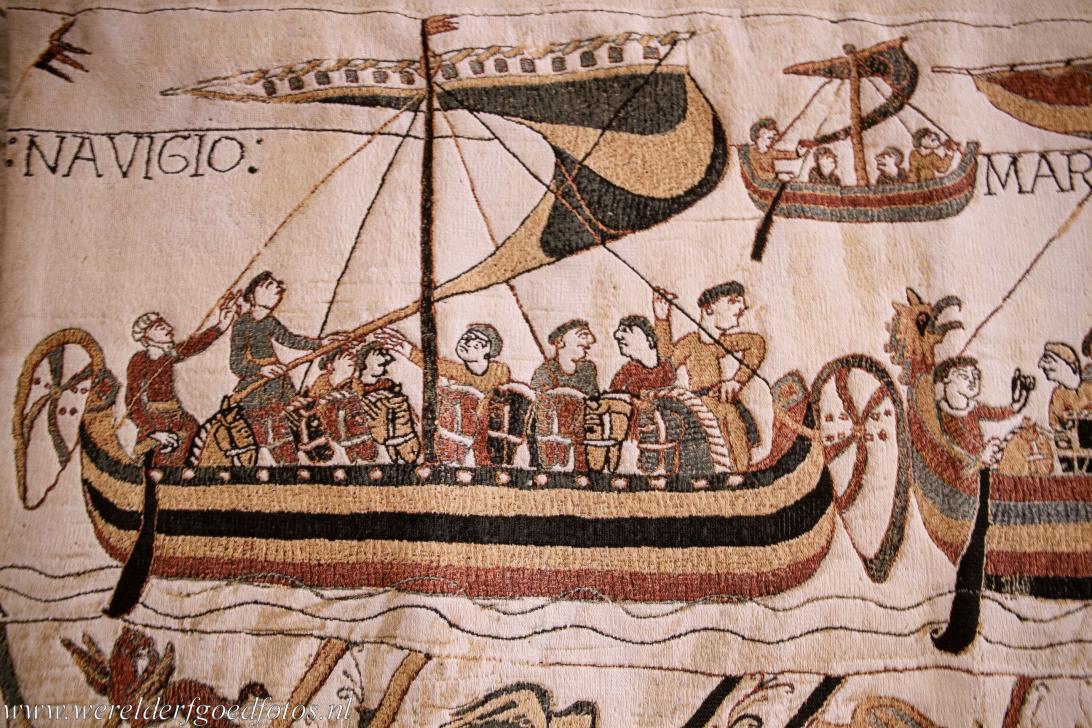
The Bayeux Tapestry is an embroidered cloth, it is almost 70 metres long and 50 cm high. It was created in the 11th century. The Bayeux Tapestry consist of 58 scenes with Latin descriptions, embroidered on white linen with coloured woollen yarns. The Bayeux Tapestry consists of nine linen panels, the panels were sewn together after each panel was embroidered, the seams were covered with embroidery.

The Bayeux Tapestry is an embroidered cloth, it is almost 70 metres long and 50 cm high. It was created in the 11th century. The Bayeux Tapestry consist of 58 scenes with Latin descriptions, embroidered on white linen with coloured woollen yarns. The Bayeux Tapestry consists of nine linen panels, the panels were sewn together after each panel was embroidered, the seams were covered with embroidery.
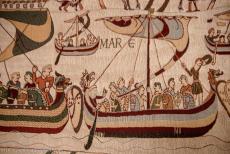
The Bayeux Tapestry depicts the journey of Harold Godwinson, Earl of Wessex, to Normandy, his relationship with William, Duke of Normandy, the Battle of Hastings and the death of King Harald Godwinson in 1066, the Norman Conquest of England and the Norman victory. William, Duke of Normandy, is also known as William the Conqueror. Harold Godwinson was the last crowned Anglo-Saxon king of England, known as King Harold II.
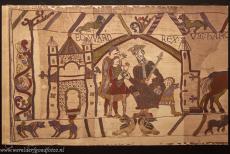
Bayeux Tapestry: The scene depicting King Edward of England sitting on his throne, talking to Harold Godwinson and Odo de Conteville, half-brother William the Conqueror. King Edward is also kown as King Edward the Confessor. After the death of King Edward, Harald Godwinson became King Harold II of England. During the Conquest of England by William the Conqueror, Harold was killed at the Battle of Hastings in 1066, Harold had been king for only eight months.
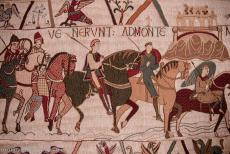
A scene from the Bayeux Tapestry depicting the Army of Duke William of Normandy passing Mont Saint Michel, a tiny island off the Normandy coast. Duke William is accompanied by Harold Godwinson, Earl of Wessex, they are setting out on a military campaign against Duke Conan II of Brittany. The main coloures used in the Bayeux Tapestry are blue-green, olive green, terracotta, russet, dull gold, also small amounts of sage green and dark blue or black were used.
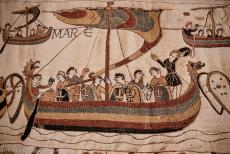
A scene from the Bayeux Tapestry depicting the Normans crossing the English Channel. The scenes of the Bayeux Tapestry are embroidered on white linen. Four embroidery stitches were used throughout the work: chain stitch, stem stitch, split stitch and the couching stitch, used to fill in large coloured surfaces. Over the course of ages, the natural grey colour of the linen cloth has changed to ecru and then to off-white.
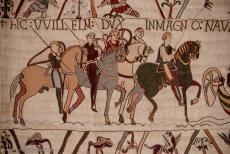
A scene from the Bayeux Tapestry depicting the horses of Duke William of Normandy, he is also known as William the Conqueror. William became first Norman king of England. The Bayeux Tapestry was embroidered on white linen with tightly twisted wool yarn, the original colours of the tapestry are reasonable stable, they have changed only a little over the course of the time, unlike the 19th-century restorations, those colours have faded more than the original colours.
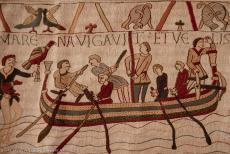
Bayeux Tapestry: One of the original scenes. It is believed that it took ten years to create the tapestry. It was displayed at the dedication of the Bayeux Cathedral in 1077 by Odo, Bishop of Bayeux, in presence of his half-brother William the Conqueror. The original end of the tapestry has been missing, it may have shown William being crowned king of England. The missing end has now been reconstructed and embroidered by islanders in Alderney, a Channel Island.
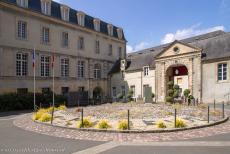
The Bayeux Tapestry is considered one of the most important works of art from the Middle Ages. The Bayeux Tapestry was housed for more than seven hundred years in the Treasury of Bayeux Cathedral. Since 1983, the tapestry has been on display in the former 17th century Grand Seminary of Bayeux, now Musée de la Tapisserie de Bayeux, Bayeux Tapestry Museum. The Bayeux Tapestry is listed on the UNESCO Memory of the World Register since 2007.
